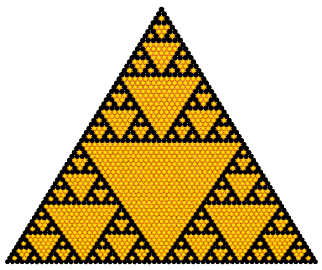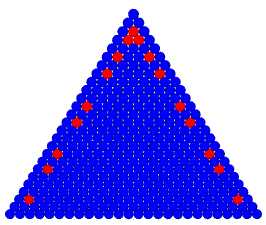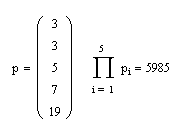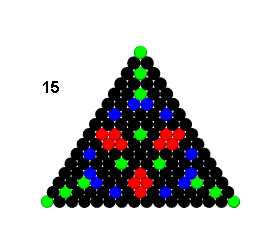|
The lcm method returns the lowest common multiple of two
numbers using the following logic: lcm(a,b) = all factors of both,
divided by factors common to both: gcd(a,b) = (a*b)/gcd(a,b).
deflcm(a,b):
# union of all factors (a*b),
# divided by gcd (factors in common)
return (a*b)/gcd(a,b)
>>> primes.getfactors(5985) # above formula shows factors intermultipied
[3, 3, 5, 7, 19]
>>> primes.getfactors(804)
[2, 2, 3, 67]
>>> primes.getfactors(1034)
[2, 11, 47]
>>> primes.gcd(1034,804) # gcd = product of primes in common
2
>>> primes.gcd(10,105)
5
>>> primes.gcd(48,60)
12
>>> primes.lcm(48,60) # lcm = product of factors in union of factor sets
240
>>> primes.lcm(1034,804)
415668
>>> series.fibo(63) # 63rd Fibonacci number
6557470319842L
>>> primes.getfactors(series.fibo(63)) # prime factors of 63rd fib. no.
[2, 13, 17, 421, 35239681L]
>>> fibs = map(series.fibo,range(1,10)) # list of 9 fibonacci numbers
>>> fibs
[1L, 1L, 2L, 3L, 5L, 8L, 13L, 21L, 34L]
>>> primes.LCM(fibs) # LCM (uppercase) accepts lists, as does GCD()
185640L
>>> primes.getfactors(18446744073709551615L) # pretty fast
[3, 5, 17, 257, 641, 65537, 6700417L]
>>> primes.getfactors(18446744073709551597L) # very hard to factor
[ eventually gives a memory error -- more than this program can handle ]
|
|
With getfactors in place, we may define a simple function
telling us how many integers less than n are are relatively prime
to n, meaning they have no factors in common. Two integers are
relatively prime if they have no common divisor other than 1
(gcd=1). For example, 1,3,7 and 9 are relatively prime to 10,
whereas 2, 4 and 5 are not.
Leonhard Euler (1707-1783) proved the product n(1-1/F0)(1-1/F1)
... (1-1/Fn) gives the number of relative primes for n, where F0,
F1... Fn are n's prime factors. The idea is to cancel every 2nd,
3rd , 5th, 7th number and so on, with (1-1/Fn) being the fraction
of integers remaining per the nth cancelation. We only want to use
each prime factor once in this product, no matter how many times it
occurs in the prime factorization. Therefore the phi (or "totient") function
keeps a list of factors already used, and skips any
reoccurances.
defphi(n):
"""
Return number of integers < n relatively prime to n."""
product = n
used = []
for i in getfactors(n):
if i not in used: # use only unique prime factors
used.append(i)
product = product * (1 - 1.0/i)
return int(product)
You might want to take this opportunity to point out to students
that this use of phi(n) -- for the number of prime residuals
< n -- is by convention, yet is of course different from the
golden mean or any function for computing this value. The Python
concepts of namespaces is relevant in this connection: every
module has its own dictionary of key terms, and prefixing the
module name (as we have been doing), helps resolve any ambiguities
that might arise from such multiple meanings. A namespace is
a context.
Notice that all integers less than a prime are relatively
prime, i.e. phi(p), where p is prime, returns an answer of
p-1.
Euler's Theorem states that if and only if a and b
are relatively prime (i.e. gcd(a,n) == 1), then
pow(a,phi(n),n) == 1 i.e. pow(a,phi(n))/n has a remainder of
1. Note that whereas phi(n) always satisfies this
condition, some smaller divisor of phi(n) may actually be the
minimal exponent for which the remainder is unity.
The thinking here is that integers relatively prime to n have
relatively prime remainders (i.e. each relative prime mod n = some
relative prime), and that any n-relative prime multiplied by all
possible relative prime remainders will result in the same
remainders all over again. So a * (all n-relative primes) mod n =
(n-relative primes) mod n, and canceling identical terms on both
sides leaves a^phi(n) = 1 mod n.
You might want to explore this assertion that "any n-relative
prime multiplied by all possible relative prime remainders will
result in the same remainders all over again" by actually testing
it for special case b and n, where gcd(b,n)=1. Collect all integers
nrp < n which are n-relative primes, and compute (b * nrp) mod n
for all of them. You should get back the same list of nrps
(n-relative primes), perhaps in a different order. Here's some
code:
defrelprimes(n,b=1):
"""
List n-relative primes, then...
List the remainders after dividing n by the product
of each n-relative prime and some relative prime b
"""
relprimes = []
for i in range(1,n):ee
if gcd(i,n)==1: relprimes.append(i)
print " n-rp's: %s" % (relprimes)
# multiply all relative primes < n by b (also an n-rp)
relprimes = map(operator.mul,[b]*len(relprimes),relprimes)
# list all the above products mod n
newremainders = map(operator.mod,relprimes,[n]*len(relprimes))
print "b * n-rp's mod n: %s" % newremainders
Usage:
>>> import primes
>>> primes.relprimes(12,5)
n-rp's: [1, 5, 7, 11]
b * n-rp's mod n: [5, 1, 11, 7]
>>> primes.relprimes(30,7)
n-rp's: [1, 7, 11, 13, 17, 19, 23, 29]
b * n-rp's mod n: [7, 19, 17, 1, 29, 13, 11, 23]
And here's some code for testing Euler's theorem. If (a,n) have
a gcd of 1, i.e. are relative primes, then this function should
always return 1.
deftesteuler(a,n):
"""Test Euler's Theorem"""
a = long(a)
if gcd(a,n)<>1:
print "(a,n) not relative primes"
else:
print "Result: %s" % pow(a,phi(n),n)
Note this use of Python's built-in pow() function, which
optionally takes a 3rd argument. pow(a,b) is equivalent to
a**b whereas pow(a,b,n) is symbolically
equivalent to (a**b)%n -- but is operationally much
faster, owing to internally-implemented shortcuts (so use it
instead).
Pierre de Fermat (1601-1655) proved that any prime must
satisfy the condition that for any integer a not a multiple
of p, a to the power of p-1, divided by p, has a
remainder of 1. In Python notation, we might write:
pow(b,p-1,p) == 1, provided of course that gcd(b,p)=1.
We call this Fermat's Little Theorem" (the "big one" being the
more famous "last" one, and proved by
Andrew Wiles in 1995). This theorem actually follows from
Euler's (above), as phi(p) = p-1, i.e. all numbers less than a
prime are relatively prime, by definition.
Setting base b=2 creates a useful test for composite numbers. If
a number fails this test, it's definitely not a
prime. If it passes, it may be prime. Candidate primes may
be further tested with higher bases, as a composite which passes
fermat for base 2
may fail for some other base. For example, 341 passes when b=2, but
fails when b=3:
>>> primes.fermat(341,2)
1
>>> primes.fermat(341,3)
0
However a few composites pass the fermat test
regardless of our selection for b -- these are the Carmichael
numbers, named for
Robert Daniel Carmichael (1879-?), of which 561 is the first.
And there's no theoretical upper limit on how many we might
generate.
Euler was also able to prove a stronger version of the Fermat's
Little Theorem, which sieves out even more composites than Fermat's
test: if p is prime, then pow(b,(p-1)/2,p) =
jacobi(b,p). The
jacobi function, named for
Carl Gustav Jacob Jacobi (1804 - 1851), returns either 1,0 or
-1. We say a mod n = -1 if the remainder of a/n is
n-1 -- something to test for in the euler function. Again, base
b is a variable.
>>> plist = primes.sieve(60)[1:] # get primes below 60, slicing off 2
>>> plist[3, 5, 7, 11, 13, 17, 19, 23, 29, 31, 37, 41, 43, 47, 53, 59]
>>> map(primes.fermat,plist) # fermat test true for all primes
[1, 1, 1, 1, 1, 1, 1, 1, 1, 1, 1, 1, 1, 1, 1, 1]
>>> map(primes.euler,plist) # euler test true for all primes
[1, 1, 1, 1, 1, 1, 1, 1, 1, 1, 1, 1, 1, 1, 1, 1]
>>> map(primes.phi,plist) # phi(p)=p-1 relative primes < n
[2, 4, 6, 10, 12, 16, 18, 22, 28, 30, 36, 40, 42, 46, 52, 58]
>>> primes.fermat(561,2) # 561 passes fermat test for base 2...
1
>>> primes.fermat(561,3) # passes for base 3 too, all bases in fact
1
>>> primes.euler(561,2) # 561 passes the Euler test, base 2
1
>>> primes.euler(561,3) # but Euler test base 3 finally finds it out
0
>>> primes.getfactors(561) # 561 is composite, is the lowest Carmichael
[3, 11, 17]
>>> primes.divtrial(561) # ...as the divtrial function discovers
0
>>> primes.gcd(8,15) # 8 and 15 are relatively prime
1
>>> pow(15,primes.phi(8),8) # testing Euler's theorem
1
>>> pow(8,primes.phi(15),15) # ditto (reversing a and b)
1
>>> primes.gcd(10,25) # 10 and 25 are not relatively prime
5
>>> pow(10L,primes.phi(25),25) # as a consequence, the remainder is not 1
0L
|





